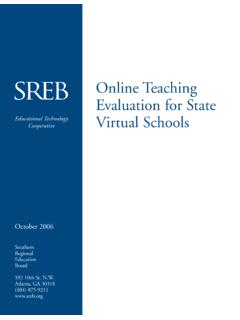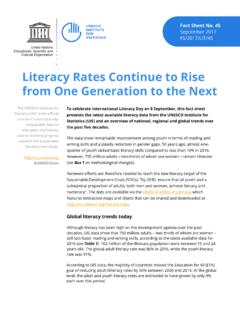Transcription of MENTORING NEW TEACHERS A fresh look - sreb.org
1 MENTORING NEW TEACHERS A fresh look How can renewed approaches to MENTORING help new TEACHERS ? Sixteen new TEACHERS attend an orientation. Their principal spends three or four hours describing the school's student learning goals, the district's evaluation rubric and options for professional learning activities. Down the hallway, four teacher mentors meet with their district coach. They are all first-time mentors and feel as apprehensive as the new TEACHERS they are about to support. How can districts and schools make mentors and new TEACHERS good at what they do? Teaching is hard. TEACHERS have limited time, resources and public support for ensuring that students with a wide variety of academic and behavioral needs meet increasingly rigorous learning expectations. New TEACHERS do this work without the benefit of experience and while juggling unique challenges associated with beginning a new career.
2 These challenges contribute to turnover among early-career TEACHERS . Approximately 77 percent of new TEACHERS stay in the profession for the duration of their first five years. Staff attrition costs districts billions of dollars, contributes to low teacher morale and disrupts student learning. In response, many school districts use MENTORING programs to support new TEACHERS . TEACHERS identify lack of administrative and instructional support as one cause of attrition. To address this, school districts across the country have designed induction programs for new TEACHERS . A common element of these programs is assigned mentors, who guide new TEACHERS ' professional learning. But not all MENTORING programs effectively help new TEACHERS . Continuum of Support The amount and types of support that new TEACHERS currently receive from MENTORING programs fall along a Continuum of No Support Support.
3 Many programs are compliance-driven or problem- New TEACHERS receive no formal help driven systems of support. Where does your district or school fall from designated mentors, or mentors on this continuum? receive no formal guidance from their district. School districts can make MENTORING programs better. This edition of the fresh Look series describes three areas that Compliance-Driven districts and schools should concentrate on when designing, As part of a required induction program, implementing or improving MENTORING programs for new new TEACHERS consult with mentors to TEACHERS . Taking action in these three areas will ensure that both complete projects, such as portfolios and professional growth plans. TEACHERS and their mentors receive the type of support with the most impact, people-driven support.
4 Problem-Driven MENTORING structures and activities are linked to specific challenges that MENTORING New TEACHERS : Action Areas early-career educators encounter in the classroom. 1. Rethink program elements that affect mentors. People-Driven 2. Address challenges that new TEACHERS really face. Mentors support TEACHERS ' entry into professional communities. The program emphasizes both teacher 3. Use a tiered process to respond to needs. and mentor growth. January 2018. 01 Rethink program elements that affect mentors. How Do Mentors Become Good at What They Do? The people who serve as mentors are the foundation of any MENTORING program. The quality of this foundation is determined by the way a district or school approaches three key program elements: Program Element #1: Mentor Selection Criteria In 29 states, laws or administrative rules define criteria for selecting mentors.
5 Most of these states require new mentors to have a minimum number of years of teaching experience and demonstrated instructional effectiveness, usually measured by past evaluation ratings. But selecting mentors using criteria such as years of experience and past evaluation scores can be problematic because teaching and MENTORING have distinct knowledge bases and skill sets. Although there is some overlap, there are significant differences. Effective mentors are not simply people who are good at providing instruction to students they are people who are good at providing personal and instructional support to adult learners. Program Element #2: Continuous Mentor Growth In addition to thinking about mentor selection, districts need plans for continuous mentor improvement. After required initial training, mentors should engage in ongoing professional learning to boost their mentee TEACHERS ' job satisfaction and instruction.
6 Professional development for mentors should improve their communication and problem-solving skills to help them build the capacity of their mentees. Mentors should receive direct coaching and participate in professional learning communities, just as new TEACHERS do. Professional growth opportunities and tools for mentors should be designed to target three content categories: Interpersonal Relationships Mentors learn how to build trusting relationships South Carolina: Program Plans with their mentees, and strategies for helping new TEACHERS adjust to their profession, district In South Carolina, the and school. Department of Education requires school districts Coaching Skills to assign mentors to all Mentors learn coaching techniques, including novice TEACHERS . Districts collecting evidence, guiding teacher self- submit plans that describe how they will reflection and providing actionable feedback.
7 Select mentors, provide at least three types of professional learning and assess the Growth for Both effectiveness of induction programs. These Mentors engage in opportunities to deepen requirements do not necessarily guarantee their knowledge of standards and content. effective mentor selection or growth, but they Deconstructing teaching practices helps mentors do set expectations for system monitoring and improve their own instructional pedagogy. define roles for district and school leaders. 2 Educator Effectiveness, January 2018 MENTORING New TEACHERS 01 Rethink program elements that affect mentors. Program Element #3: Human Capital Structure In most cases, mentors are other TEACHERS at a mentee's school. Although there are many advantages to this, it also results in two crucial challenges for districts to address: Muddied Professional Roles When the people who mentor new TEACHERS are full-time TEACHERS themselves, confusion can arise about the distinctions among an assortment of school-based roles, including formal mentors, informal mentors, classroom TEACHERS , teacher-leaders and instructional coaches.
8 The How and When of MENTORING Mentors are already busy in their professional role as classroom TEACHERS , providing people-driven support to the students in their classrooms. If MENTORING duties are simply tacked on top of these teaching duties, it limits the time and energy available for quality MENTORING resulting in new TEACHERS who receive inconsistent and compliance-driven support. Mentors need protected time to engage in MENTORING activities, such as attending training sessions, preparing MENTORING materials, and observing and meeting with their mentees. Some districts attempt to address this by calling for release time for mentors. However, release time is often stipulated using vague language. This inadvertently sends a message that MENTORING activities (and the results they produce) are not truly valued, because mentors' ability to routinely use their release time to help new TEACHERS is not clearly defined or safeguarded.
9 Furthermore, release time typically results in a substitute taking over a mentor's teaching responsibilities so that they can fulfill their MENTORING responsibilities. This merely shifts responsibilities around and requires mentors to spend additional time preparing for a substitute. So, throwing release time at the problem does not help mentors commit meaningful time or support to new TEACHERS consistently, and in some cases, it can even make the problem worse. Colorado: Retirees as Mentors Although most mentors are school-based, in some cases, new TEACHERS are matched with district-level staff or a mentor from an outside program. Some school districts, such as Washington, , public schools, use retired TEACHERS to mentor new TEACHERS . In Aurora Public Schools in Colorado, a group of TEACHERS in their first three years of teaching in the district were paired with a retired mentor.
10 Although the program did not significantly affect evaluation scores or retention rates, students taught by participating TEACHERS had higher math and reading achievement than students of TEACHERS with similar levels of experience who did not participate in the program. Educator Effectiveness, January 2018 MENTORING New TEACHERS 3. Taking Action: Steps for District and School Leaders 01. Rethink program elements that affect mentors. First Steps Reframe mentor selection criteria Gather input from school administrators, current mentors and TEACHERS to identify personality characteristics, work habits and skills that predict aptitude for good MENTORING . Use this information to develop or adapt the process and criteria that are used to select mentors. Make sure selected mentors exhibit exemplary instructional practice that is cross-validated from a variety of sources, such as personal references, video clips, and both formal and informal evaluations.







